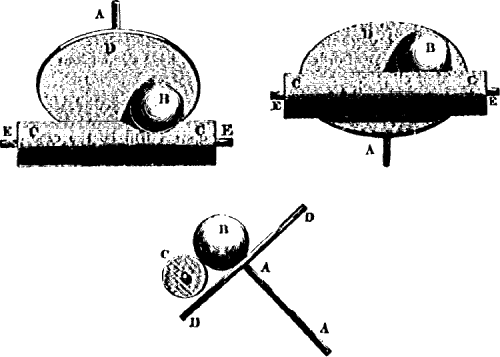“Harmonic Analyzer.”
Shown and explained by Sir William Thomson, F.R.S.,
Professor of Natural Philosophy in the University of Glasgow
Received May 9, 1878.
Proceedings of the Royal Society of London, Vol. 27, 1878, pp. 371-373
[Equations reformatted from original due to HTML limitations.]
This is a realization of an instrument designed rudimentarily in the author’s communication to the Royal Society (“Proceedings,” February 3rd, 1876 [vol. 24]), entitled “On an Instrument for Calculating (∫Φ(x)ψ(x)dx), the Integral of the Product of two given Functions.”
It consists of five disk globe and cylinder integrators of the kind described in Professor James Thomson’s paper “On an Integrating Machine having a new Kinematic Principle,” of the same date, and represented in the annexed woodcuts.
The five disks are all in one plane, and their centres in one line. The axes of the cylinders are all in a line parallel to it. The diameters of the five cylinders are all equal, so are those of the globes; hence the centres of the globes are in a line parallel to the line of the centres of the disks, and to the line of the axes of the cylinders.
One long wooden rod, properly supported and guided, and worked by a rack and pinion, carries five forks to move the five globes and a pointer to trace the curve on the paper cylinder. The shaft of the paper cylinder carries at its two ends cranks at right angles to one another; and a toothed wheel which turns a parallel shaft, and a third shaft in line with the first, by means of three other toothed wheels. This third shaft carries at its two ends two cranks at right angles to one another.

Another toothed wheel on the shaft of the paper drum turns another parallel shaft, which, by a slightly oblique toothed wheel working on a crown wheel with slightly oblique teeth, turns one of the five disks uniformly (supposing to avoid circumlocution the paper drum to be turning uniformly). The cylinder of the integrator, of which this one is the disk, gives the continuously growing value of ∫ydx.
Each of the four cranks gives a simple harmonic angular motion to one of the other four disks by means of a slide and crosshead; carrying a rack which works a sector attached to the disk. Hence, the cylinders moved by the disks, driven by the first mentioned pair of cranks, give the continuously growing values of
where c denotes the circumference of the paper drum: and the two remaining cylinders give
where w denotes the angular velocity of the shaft carrying the second pair of shafts, that of the first being unity.
The machine, with the toothed wheels actually mounted on it when shown to the Royal Society, gave w=2, and was therefore adopted for the meteorological application. By removal of two of the wheels and substitution of two others, which were laid on the table of the Royal Society, the value of w becomes (39×109)/(40×110) [1] (according to factors found by Mr. E. Roberts, and supplied by him to the author, for the ratio of the mean lunar to the mean solar periods relatively to the earth’s rotation). Thus, the same machine can serve for analysing out simultaneously the mean lunar and mean solar semi-diurnal tides from a tide-gauge curve. But the dimensions of the actual machine do not allow range enough of motion for the majority of tide-gauge curves, and they are perfectly sufficient and suitable for meterological work. The machine, with the train giving w=2, is therefore handed over to the Meteorological Office to be brought immediately into practical work by Mr. Scott (as soon as a brass cylinder of proper diameter to suit the 24h length of his curves is substituted for the wooden model cylinder in the machine as shown to the Royal Society): and the construction of a new machine for the tidal analysis, to have eleven disk globe and cylinder integrators in line, and nine crank shafts having their axes in line with the paper drum, according to the preceding description, in proper periods to analyse a tide curve by one process for mean level, and for the two components of each of the five chief tidal constituents—that is to say,
(1.) The mean solar semi-diurnal;
(2.) „ „ lunar „
(3.) „ „ lunar quarter diurnal, shallow water tide;
(4.) „ „ lunar declinational diurnal;
(5.) „ „ luni-solar declinational diurnal;
is to be immediately commenced. It is hoped that it may be completed without need to apply for any addition to the grant already made by the Royal Society for harmonic analysers.
Counterpoises are applied to the crank shafts to fulfil the condition that gravity on cranks, and sliding pieces, and sectors, is in equilibrium. Error from “back lash” or “lost time” is thus prevented simply by frictional resistance against the rotation of the uniformly rotating disk and of the tertiary shafts, and by the weights of the sectors attached to the oscillating disks.
Footnotes
-
[1] The actual numbers of the teeth in the two pairs of wheels constituting the train are 78:80 and 109:110.